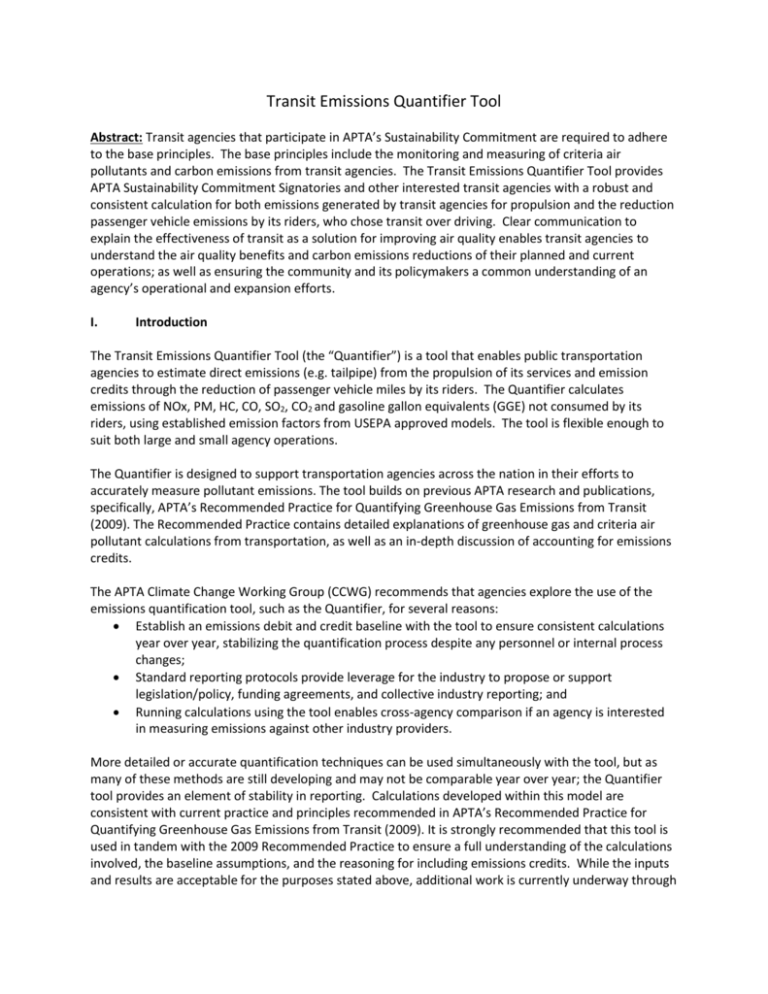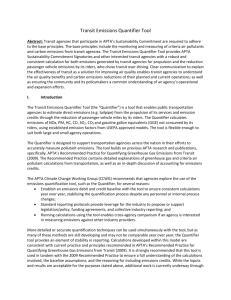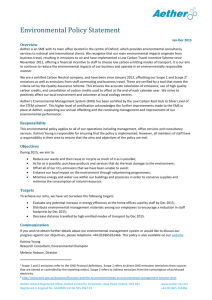Transit Emissions Quantifier Tool
advertisement

Transit Emissions Quantifier Tool Abstract: Transit agencies that participate in APTA’s Sustainability Commitment are required to adhere to the base principles. The base principles include the monitoring and measuring of criteria air pollutants and carbon emissions from transit agencies. The Transit Emissions Quantifier Tool provides APTA Sustainability Commitment Signatories and other interested transit agencies with a robust and consistent calculation for both emissions generated by transit agencies for propulsion and the reduction passenger vehicle emissions by its riders, who chose transit over driving. Clear communication to explain the effectiveness of transit as a solution for improving air quality enables transit agencies to understand the air quality benefits and carbon emissions reductions of their planned and current operations; as well as ensuring the community and its policymakers a common understanding of an agency’s operational and expansion efforts. I. Introduction The Transit Emissions Quantifier Tool (the “Quantifier”) is a tool that enables public transportation agencies to estimate direct emissions (e.g. tailpipe) from the propulsion of its services and emission credits through the reduction of passenger vehicle miles by its riders. The Quantifier calculates emissions of NOx, PM, HC, CO, SO2, CO2 and gasoline gallon equivalents (GGE) not consumed by its riders, using established emission factors from USEPA approved models. The tool is flexible enough to suit both large and small agency operations. The Quantifier is designed to support transportation agencies across the nation in their efforts to accurately measure pollutant emissions. The tool builds on previous APTA research and publications, specifically, APTA’s Recommended Practice for Quantifying Greenhouse Gas Emissions from Transit (2009). The Recommended Practice contains detailed explanations of greenhouse gas and criteria air pollutant calculations from transportation, as well as an in-depth discussion of accounting for emissions credits. The APTA Climate Change Working Group (CCWG) recommends that agencies explore the use of the emissions quantification tool, such as the Quantifier, for several reasons: Establish an emissions debit and credit baseline with the tool to ensure consistent calculations year over year, stabilizing the quantification process despite any personnel or internal process changes; Standard reporting protocols provide leverage for the industry to propose or support legislation/policy, funding agreements, and collective industry reporting; and Running calculations using the tool enables cross-agency comparison if an agency is interested in measuring emissions against other industry providers. More detailed or accurate quantification techniques can be used simultaneously with the tool, but as many of these methods are still developing and may not be comparable year over year; the Quantifier tool provides an element of stability in reporting. Calculations developed within this model are consistent with current practice and principles recommended in APTA’s Recommended Practice for Quantifying Greenhouse Gas Emissions from Transit (2009). It is strongly recommended that this tool is used in tandem with the 2009 Recommended Practice to ensure a full understanding of the calculations involved, the baseline assumptions, and the reasoning for including emissions credits. While the inputs and results are acceptable for the purposes stated above, additional work is currently underway through others, specifically in the area of land-use and transit co-benefits that could replace the default values used throughout the Quantifier. The results of the Quantifier should be considered conservative with the highest value of providing an annual comparison of air quality benefits for the purposes of continual improvement. II. Data Needs Source 1: Type of Fleet (i.e. Bus, Locomotive, Light Rail, Van, etc.) Source 2: Vehicle Group (e.g. No. of Buses in a Manuf. Year) Source 3: Fuel Volume (Total gallons/year for a model year) Source 4: Vehicle miles travelled for fleet count (Total miles/year for a model year): On Highway Only Source 5: Vehicle Revenue Miles (VRM) from NTD Source 6: Passenger Miles Travelled (PMT) from NTD Source 7: Seat capacity of each vehicle type in a model year III. Screen-Specific Instructions The “NTD” tab provides users with the primary data field inputs for each mode of transportation that they may offer: Commuter Rail (CR) – Diesel and Electric Heavy Rail (HR) – Electric Light Rail (LR) – Electric Streetcar (SR) – Electric Trolley Bus (TB) - Electric Bus (MB) – Compressed Natural Gas (CNG), Diesel and Electric Bus Rapid Transit (RB) –CNG, Diesel and Electric Commuter Bus (CB) – CNG and Diesel Vanpool (VP) – CNG, Diesel and Gasoline All YELLOW fields are open for user input or adjustment. All GREEN fields are static; containing USEPA established emissions rates or calculations. The first table on the NTD worksheet should be populated with available data for Energy/Fuel, Unlinked Trips, Vehicle-Miles, and Passenger-Miles from NTD. Seat-Miles can be determined, using APTA’s Standards Sustainability Metrics for Criteria Air Pollutants: Calculation Methods. National T rans it D ata E nergy/F uel Unlinked T rips Vehic le -Miles P as s enger-Miles C ommuter R ail (D ies el) C ommuter R ail (kW h) Heavy R ail (kW h) L ight R ail (kW h) S treetc ar (kW h) T rolley B us (kW h) F ixed R oute B us (C NG ) F ixed R oute B us (D ies el) F ixed R oute B us (kW h) B us R apid T rans it (C NG ) B us R apid T rans it (D ies el) B us R apid T rans it (kW h) C ommuter B us (C NG ) C ommuter B us (D ies el) Vanpool (C NG ) Vanpool (D ies el) Vanpool (G as oline) P MT /T rip S eat-Miles 0.00 0.00 0.00 0.00 0.00 0.00 0.00 0.00 0.00 0.00 0.00 0.00 0.00 0.00 0.00 0.00 0.00 The second table on the NTD worksheet should be populated with data from USEPA’s eGRID data for electricity generation and USEPA’s Air Emission Sources Where You Live. Megawatt-Hours (MWh) Annual NO x E mis s ions (tons ) eGR ID 2012 Vers ion 1.0 (Y ear 2009 D ata) Annual NMHC Annual C O Annual P M E quivalent (tons ) E quivalent (tons ) E quivalent (tons ) Annual S O 2 E quivalent (tons ) Annual C O 2 E quivalent (tons ) Recommended data from USEPA’s MS Excel eGRID data field “ST09 – State annual net generation (MWh)” and “ST09 – State annual CO2 equivalent emissions (tons)”. The “State annual NOX emissions (tons)” and “State annual SO2 emissions (tons)” are available, as well, but may be obtained, using USEPA’s Air Emissions Sources Where You Live. Either source is acceptable for NOX and SO2. At the bottom of USEPA’s web site Where You Live (http://www.epa.gov/air/emissions/where.htm) is a section called “Create a File by State or Source Type”. Step 1: select your state; Step 2: select “Electricity Generation via Combustion”; Step 3: select Pollutant (it does not matter, as it will down load all of the pollutants); skip Step 4; Step 5: choose file type. You will receive all of the emissions for each point source in the selected state. Step 6: Sort out “Electricity Generation via Combustion”. Step 7: Sort the data by “Pollutant”. Sum each pollutant in tons and enter into the table on the NTD worksheet. Recommendation: use PM10 sum and not PM2.5. The third table on the NTD worksheet contains emission rates for each mode of transportation. The yellow fields for “Bus – Diesel (grams/mile)” are determined, using APTA’s Standards Sustainability Metrics for Criteria Air Pollutants: Calculation Methods. Nitriogen O xides C ommuter R ail (grams /gallon) E lec tric P ropuls ion (grams /kW h) B us -C NG (grams /mile) B us -D ies el (grams /mile) Vanpool -C NG (grams /mile) Vanpool -D ies el (grams /mile) Vanpool -Gas (grams /mile) S ingle O c c upied C ar (grams /mile) 0.000 0.22 0.226 1.467 0.95 0.693 Nonmethane Hydroc arbons C arbon Monoxide 0.000 0.02 0.14 0.143 0.191 1.224 1.034 0.000 10.02 0.74 2.632 0.758 11.84 9.4 P artic ulate Matter 0.0000 0.0030 0.0334 0.1388 0.0094 0.0085 Gas oline Gallon S ulfur O xides Greenhous e Gas E quivalent(GGE ) 0.0000 10,210 0.88 0.0000 0.000 33.40 0.0000 0 126.67 0.0000 0 0.88 0.0000 0 126.67 0.0000 0 0.88 0.0000 0 0.0000 0.0070 368.4 0.04149 The yellow fields for “Commuter Rail (grams/gallon)” are determined by inputting the values in the green fields from the table “Diesel Locomotive Line-Haul Emission Factors” of the criteria air pollutants for the corresponding Tier of your locomotive fleet. For fleets that have locomotives with multiple tier engines, a weighted value by the number of locomotives in each tier may be used; or if the actual gallon consumption of each locomotive is known, then the total grams for each criteria air pollutant from each locomotive can be summed and divided by the total gallons of diesel consumed by the fleet. D ies el L oc omotive L ine - Haul E mis s ion F ac tors g/bhp-hr T ier 0 T ier 0+ T ier 1 T ier 1+ T ier 2 T ier 2+ T ier 3 T ier 4 P M10 g/gallon 0.32 0.20 0.32 0.20 0.18 0.08 0.08 0.02 HC g/bhp-hr 6.66 4.16 6.66 4.16 3.74 1.66 1.66 0.31 NO x g/gallon 0.48 0.30 0.47 0.29 0.26 0.13 0.13 0.04 g/bhp-hr 9.98 6.24 9.78 6.03 5.41 2.70 2.70 0.83 CO g/gallon 8.60 7.20 6.70 6.70 4.95 4.95 4.95 1.00 g/bhp-hr 178.88 149.76 139.36 139.36 102.96 102.96 102.96 20.80 g/gallon 1.28 1.28 1.28 1.28 1.28 1.28 1.28 1.28 The Quantifier tool enables the user to provide various data inputs that automatically calculates transit’s emissions and emissions credits based on what is provided. The tool contains ten (10) worksheets (one for each transit mode) and 1 worksheet that summarizes the overall transit agency. “Comm Rail – Diesel” “Comm Rail – Electric” “Heavy Rail” “Light Rail” “Streetcar” “Trolley Bus” “Fixed Route Bus” “Bus Rapid Transit” “Commuter Bus” “Vanpool” “Transit Agency” Each worksheet has a table that should be populated with data described in APTA’s Recommended Practice: Quantifying Greenhouse Gas Emissions from Transit. Mode S hift (Ms ) C onges tion R elief (C r) L and-Us e Multiplier Average Vehic le O c c upanc y P ounds =453.6 grams /lbs T ons =907200 grams /ton R iders hip Inc reas e % 1.9 1.39 907200 Mode Shift (Ms) reflects those riders with access to a vehicle within an agency’s service area. The Ms factor is expected to rise with an increase in population service area. Service Area Type and Population All Systems Small, <500,000 Med. 500,000 – 1,250,000 Large, >1,250,000 Transit Performance Monitoring System (2002) 0.44 0.34 0.42 0.47 Transit Performance Monitoring System (2004) 0.45 0.39 0.43 0.50 26.62 26.62 26.62 26.62 26.62 26.62 26.62 26.62 Lg. Suburban, >1,250,000 0.44 0.52 Congestion Relief (Cr) is the estimated additional fuel that would be consumed if public transportation service were discontinued. The Texas Transportation Institute’s Urban Mobility Report lists the data in the Ms Excel field “Condition if Public Transportation Service were Discontinued – Additional Wasted Fuel (1000 gals)” for service area type and 101 urban cities. Land-Use Multiplier the indirect impacts of transit that reduce vehicle travel by: 1) reduced trip lengths; 2) facilitation of bicycle and pedestrian travel; 3) trip chaining; and 4) impacts through vehicle ownership. The national default multiplier is 1.9 by ICF International. Average Vehicle Occupancy of 1.39 is based on the National Household Travel Survey. Pounds / Tons by entering 453.6 grams/lbs or 907200 grams/ton all graphs will update to report emissions in pounds or tons. This conversion is useful for small agencies or projects. Ridership Increase % allows the user to input an increase in rider ship that will be graphed along with the agency’s performance, current ridership and seat capacity offered. Note: Changes in ridership are only calculated for mode shift and land-use multiplier. There are no changes to congestion relief, as this relationship has not been established. All BLUE fields are calculated outputs that contain pollutant emissions by the transit agency (debit). All GREEN fields are pollutant emissions not emitted from passenger vehicles, who choose transit over driving, and pollutant emissions by seat capacity for each mode offered by the transit agency (credit). All YELLOW fields are open for user input or adjustment to demonstrate variations in ridership or landuse multiplier. Note: Graphs will automatically adjust when inputs are made. Each criteria air pollutant, greenhouse gases and gasoline gallon equivalents saved are graphed individually. Additionally, criteria air pollutants (NOX, HC, CO, PM, SO2) are summarized in a graph, as well. Worksheet Specific Data Entry For agencies that operate diesel locomotives for commuter rail service there are entry fields to upgrade a percentage of your fleet to Tier 1, 2, 3 or 4. Step 1: Enter a Tier in the YELLOW field to the right of the “Tier” field. Step 2: Enter a percent of your fleet in the YELLOW field to the right of the “Fleet Change” field. This will replace a percentage of your current fleet with the tier that you entered in Step 1. Your remaining fleet will produce emissions based on the emission factors that you entered in the “NTD” worksheet. Fuel consumption will remain constant for the entire fleet, which assumes the current amount of your commuter rail service. “Commuter Rail – Diesel” Mode S hift (Ms ) C onges tion R elief (C r) L and-Us e Multiplier Average Vehic le O c c upanc y P ounds =453.6 grams /lbs T ons =907200 grams /ton T ier F leet C hange % R iders hip Inc reas e % “Transit Agency” 1.9 1.39 907200 C ommuter R ail (C R ) T ier UT A C urrent F leet % F leet C hange R ider S avings % Inc reas e R iders C urrent R iders hip For agencies that operate fixed route bus (MB), bus rapid transit (BR), commuter bus (CB), or vanpool (VP) service there are fields to make changes to your fleet, as to fuel type. The example presented here is for fixed route bus. Step 1: Enter a % in the YELLOW field to the right of the “CNG”, “diesel”, and/or “Electric” field. Step 2: If you do NOT operate a bus type that you entered a % for in step 1, then you must enter an mpg in the YELLOW field adjacent to the “CNG”, “diesel”, and/or “Electric” field (maybe adjacent to the “%” field). For electric use kWh/mile. There are literature values2 for mpg (e.g. CNG = 3.5 mpg (GGE), Diesel = 4.4 mpg, Electric = 3.2 kWh/mile). Note: If you enter a % for a fuel type already in your fleet, the Quantifier will calculate an mpg based on the performance of your current fleet of that fuel type, but not display it in the YELLOW field for mpg. This will replace a percentage of your current fleet with the % that you entered in Step 1. Your remaining fleet will produce emissions based on the emission factors in the “NTD” worksheet. Vehicle miles will remain constant for the entire fleet, which assumes the current amount of your service. As stated in Step2, you can enter a % for a fleet type not currently in your fleet. Again, the Quantifier will replace a portion of your fleet with the new type of bus, as if you had them, using the mpg you entered in step 2. If you enter a % change for diesel buses, the Quantifier assumes that you are purchasing new diesel buses and will use the most current emission rates for EPA’s “clean” diesel buses (i.e. NOx = 0.86 gr/mile, PM = 0.0468 gr/mile). “Fixed Route Bus” Mode S hift (Ms ) C onges tion R elief (C r) L and-Us e Multiplier Average Vehic le O c c upanc y P ounds = 453.6 grams /lbs T ons = 907200 grams /ton C NG F leet % D ies el F leet % E lec tric F leet % R iders hip Inc reas e % “Transit Agency” Mus t B e: < = 1 G allons of G as 1.9 National Average 1.39 Mus t B e: > = 1 907200 MP G kW h/mile F ixed R oute B us (MB ) UT A miles /GGE miles /gallon kW h/mile C urrent F leet % F leet C hange C NG D ies el E lec tric R ider S avings % Inc reas e R iders C urrent R iders hip The Transit Emissions Quantifier Tool The Quantifier is provided to support transportation agencies across the nation in their efforts to accurately measure pollutant emissions. The tool builds on previous APTA research and publications, specifically, APTA’s Recommended Practices for Quantifying Greenhouse Gas Emissions from Transit, published in 2009. This 2009 guidance document contains detailed explanations of GHG and criteria air pollutant calculations from transportation, as well as an in-depth discussion of accounting for emissions credits. The Quantifier is intended to compliment the 2009 Recommended Practice. APTA is distributing this tool to reduce the time and effort needed for this effort, and to facilitate emissions accounting in a manner consistent with the 2009 Recommended Practice. The CCWG strongly recommends using this tool in tandem with the 2009 Recommended Practice to ensure a full understanding of the calculations involved, the baseline assumptions, and the reasoning for including emissions credits. References: 1) 20120227-Diesel_vs_CNG_FINAL_MJBD.pdf, www.mjbradley.com 2) Guidebook For Evaluating Fuel Choices For Post-2010 Transit Bus Procurement, TCRP Report 146, Library of Congress Control Number 2011929842 3) Full Fuel Cycle Assessment: Well-To-Wheels Inputs, Emissions, And Water Impacts, TIAX LLC, June 2007, CEC-600-2007-004-F 4) Quantifying Greenhouse Gas Emissions from Transit, APTA SUDS-CC-RP-001-09 5) EGRID2012V1_0_year09_DATA.xls 6) http://mobility.tamu.edu/ums/ Excel spreadsheet - 101 urban areas 7) http://www.epa.gov/air/emissions/where.htm 8) Average Annual Emissions and Fuel Consumption for Gasoline-Fueled Passenger Cars and Light Trucks, Office of Transportation and Air Quality, EPA420-F-08-024, October 2008









